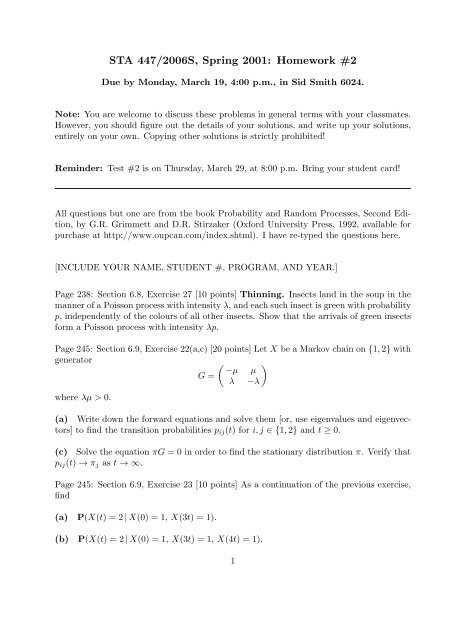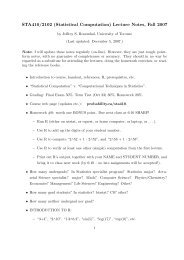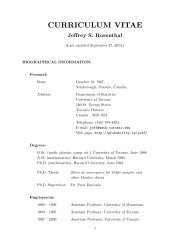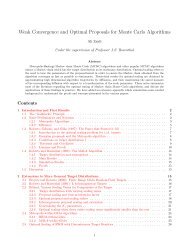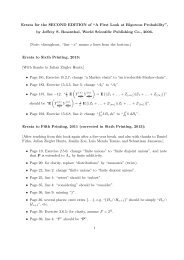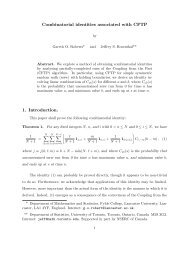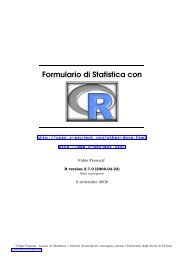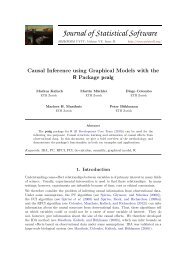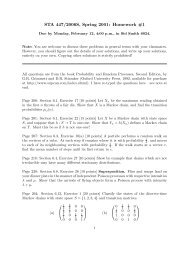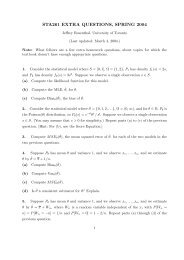STA 447/2006S, Spring 2001: Homework #2 - probability.ca
STA 447/2006S, Spring 2001: Homework #2 - probability.ca
STA 447/2006S, Spring 2001: Homework #2 - probability.ca
Create successful ePaper yourself
Turn your PDF publications into a flip-book with our unique Google optimized e-Paper software.
<strong>STA</strong> <strong>447</strong>/<strong>2006S</strong>, <strong>Spring</strong> <strong>2001</strong>: <strong>Homework</strong> <strong>#2</strong><br />
Due by Monday, March 19, 4:00 p.m., in Sid Smith 6024.<br />
Note: You are welcome to discuss these problems in general terms with your classmates.<br />
However, you should figure out the details of your solutions, and write up your solutions,<br />
entirely on your own. Copying other solutions is strictly prohibited!<br />
Reminder: Test <strong>#2</strong> is on Thursday, March 29, at 8:00 p.m. Bring your student <strong>ca</strong>rd!<br />
All questions but one are from the book Probability and Random Processes, Second Edition,<br />
by G.R. Grimmett and D.R. Stirzaker (Oxford University Press, 1992, available for<br />
purchase at http://www.oup<strong>ca</strong>n.com/index.shtml). I have re-typed the questions here.<br />
[INCLUDE YOUR NAME, STUDENT #, PROGRAM, AND YEAR.]<br />
Page 238: Section 6.8, Exercise 27 [10 points] Thinning. Insects land in the soup in the<br />
manner of a Poisson process with intensity λ, and each such insect is green with <strong>probability</strong><br />
p, independently of the colours of all other insects. Show that the arrivals of green insects<br />
form a Poisson process with intensity λp.<br />
Page 245: Section 6.9, Exercise 22(a,c) [20 points] Let X be a Markov chain on {1, 2} with<br />
generator<br />
( )<br />
−µ µ<br />
G =<br />
λ −λ<br />
where λµ > 0.<br />
(a) Write down the forward equations and solve them [or, use eigenvalues and eigenvectors]<br />
to find the transition probabilities p ij (t) for i, j ∈ {1, 2} and t ≥ 0.<br />
(c) Solve the equation πG = 0 in order to find the stationary distribution π. Verify that<br />
p ij (t) → π j as t → ∞.<br />
Page 245: Section 6.9, Exercise 23 [10 points] As a continuation of the previous exercise,<br />
find<br />
(a) P(X(t) = 2 | X(0) = 1, X(3t) = 1).<br />
(b) P(X(t) = 2 | X(0) = 1, X(3t) = 1, X(4t) = 1).<br />
1
Page 397: Section 10.2, Exercise 14 [10 points] Planes land at Heathrow airport at the<br />
times of a renewal process with interarrival time having cumulative distribution function<br />
F . Each plane independently contains a random number of people which are i.i.d. with<br />
finite mean. Find an expression for the rate of arrival of passengers over a long time period.<br />
Page 411: Section 10.5, Exercise 5 [15 points] Let N be a Poisson process with intensity<br />
λ. Show that the total lifetime D(t) = T N(t)+1 − T N(t) at time t (i.e., the length of the<br />
interarrival time which contains t) has distribution function P(D(t) ≤ x) = 1 − (1 +<br />
λ min(t, x))e −λx for x ≥ 0. Deduce that E(D(t)) = (2 − e −λt ) / λ. This is the ‘inspection<br />
paradox’.<br />
Page 411: Section 10.5, Exercise 6 [10 points] A Type I counter records the arrivals of<br />
radioactive particles. Suppose that the arrival process is Poisson with intensity λ, and<br />
that the counter is locked for a dead period of fixed length T after each detected arrival.<br />
Show that the detection process Ñ is a renewal process with interarrival time distribution<br />
˜F (x) = 1 − e −λ(x−T ) if x ≥ T . Find an expression for P(Ñ(t) ≥ k).<br />
Page 413: Section 10.5, Exercise 17(a) [20 points]<br />
(i) A word processor has 100 different keys and a monkey is tapping them (uniformly) at<br />
random. Assuming no power failure, use the elementary renewal theorem to find the expected<br />
number of keys tapped until the first appearance of the sequence ‘W. Shakespeare’.<br />
(ii)<br />
Answer the same question for the sequence ‘omo’.<br />
Final Question: [10 points] Let M and N be positive integers. Let { ̂X n } be a discretetime<br />
Markov chain on the state space S = {−M, −M +1, . . . , −1, 0, 1, 2, . . . , N}, such that<br />
p 0,1 = p 0,−1 = 1/2, and p i,i+1 = 1 for 1 ≤ i ≤ N − 1, and p i,i−1 = 1 for −M + 1 ≤ i ≤ −1,<br />
and p −M,0 = p N,0 = 1. Let {X(t)} t≥0 be the exponential holding time modifi<strong>ca</strong>tion of<br />
{ ̂X n }, with exponential holding time parameter λ. Compute lim t→∞ P(X(t) = N). [Hint:<br />
Use W.L. Smith’s Theorem.]<br />
2


